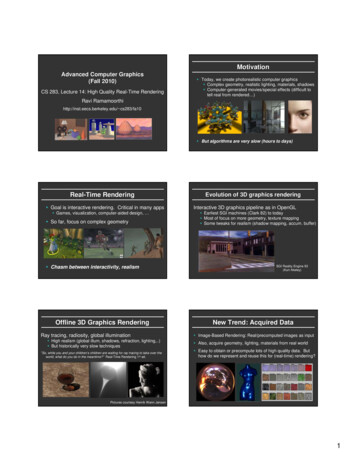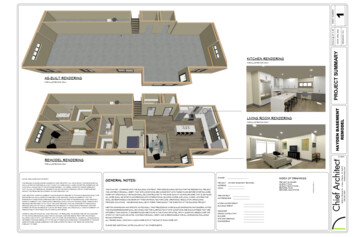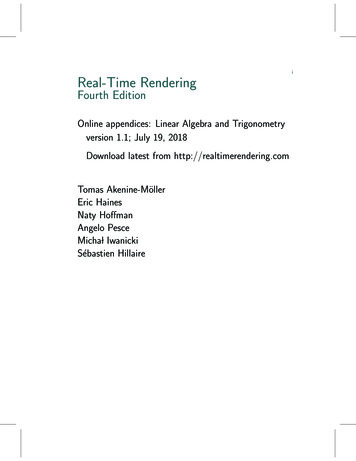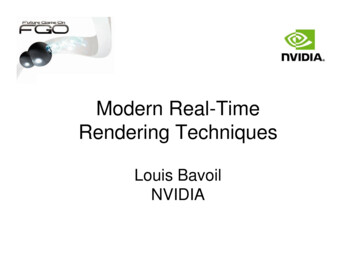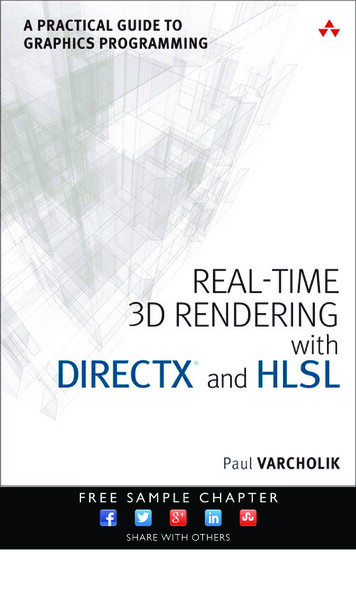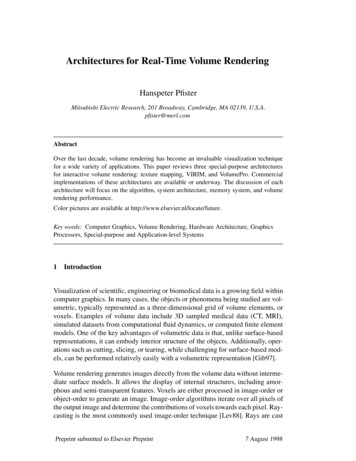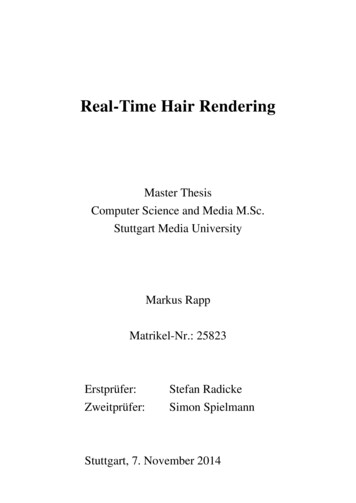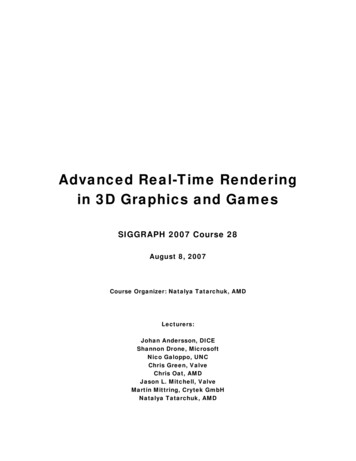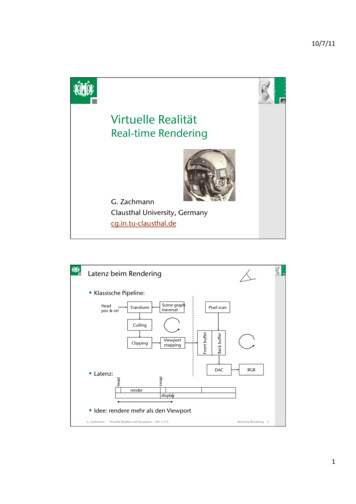
Transcription
Virtual RealityReal-time RenderingG. ZachmannUniversity of Bremen, Germanycgvr.cs.uni-bremen.de
Sources of Latency During Rendering§ Classical Pipeline:Scene ngPixel scanBack bufferTransformFront bufferHeadpos & oriDACRGBheadswap§ Latency:Mainlooprenderdisplay§ Idea: render more than one viewportG. ZachmannVirtual Reality & SimulationWS 9 November 2012Real-Time Rendering2
Viewport Independent Rendering§ Conceptional idea:§ Render the scene onto a sphere around the viewer§ If viewpoint rotates: just determine new cutout of the sphericalviewport§ Practical implementation: use cube as a viewport around user,instead of sphere (see also Cave)G. ZachmannVirtual Reality & SimulationWS 9 November 2012Real-Time Rendering3
§ New pipeline:Scene ingMainloopPixel scanMainloopFront bufferHeadposLocatepixelBack bufferHead orientationClippingAnti-AliasingRGBswap§ Latency:DACheadrenderG. ZachmannVirtual Reality & SimulationdisplayWS 9 November 2012Real-Time Rendering4
Image Composition§ Conceptional idea:§ Each thread renders only "its own" object in its own framebuffer§ Video hardware reads framebuffer including Z-buffer§ Image compositor combines individual images by comparing Z perpixel§ In praxi:§ Partition set of objects§ Render each subset on one PCG. ZachmannVirtual Reality & SimulationWS 9 November 2012Real-Time Rendering5
Another technique: Prioritized Rendering§ Observation: images of objects far away from viewpoint (or slowrelative to viewpoint) change slowly§ Idea: render onto several cuboid viewport "shells" around user§ Fastest objects on innermost shell, slowest/distant objects on outer shell§ Re-render innermost shell very often, outermost very rarely§ How many shells must be re-rendered depends on:§ Framerate required by application§ Complexity of scene§ Speed of viewpoint§ Speed of objects (relative to viewpoint)§ Human factors have influence on priority, too:§ Head cannot turn by 180 in one frame objects "behind" must be updated only rarely§ Objects being manipulated must have highest priority§ Objects in peripheral field of vision can be updated less oftenG. ZachmannVirtual Reality & SimulationWS 9 November 2012Real-Time Rendering6
Constant Framerate by "Omitting"§ Reasons for a constant framerate:§ Prediction in predictive filtering of tracking data of head/hands worksonly, if all subsequent stages in the pipeline run at a known (constant)rate§ Jumps in framerate (e.g., from 60 to 30 Hz) are very noticeable§ Rendering is "time-critical computing":§ Rendering gets a certain time budget (e.g., 17 msec)§ Rendering algorithm has to produce an image "as good as possible"§ Techniques for "Omitting" stuff:§ Levels-of-Detail (LODs)§ Omit invisible geometry (Culling)§ Image-based rendering§ Reduce the lighting model, reduce amount of textures,§ . ?G. ZachmannVirtual Reality & SimulationWS 9 November 2012Real-Time Rendering7
The Level-of-Detail Technique§ Definition:A level-of-detail (LOD) of an object is a reduced version,i.e. that has less polygons.§ Example:G. ZachmannVirtual Reality & SimulationWS 9 November 2012Real-Time Rendering8
§ Idea: render that LOD that fits the distance from the viewpoint,i.e., where users can't see the difference from the full-res. Version§ The technique consists of two tasks:1. Preprocessing: for each object in the scene, generate k LODs2. Runtime: select the "right" LODs, make switch unnoticeableG. ZachmannVirtual Reality & SimulationWS 9 November 2012Real-Time Rendering9
Selection of LODLOD§ Visual quality against "temporal quality"§ Static selection algorithm:100%50%30%§ Level i for a distance range§ Depends on FoV§ Problem: size of objectsis not considered§ For some desktop applications,e.g. terrain rendering,this is already sufficient:G. ZachmannVirtual Reality & SimulationWS 9 November 2012Real-Time Rendering10
§ Dynamic selection algorithm:§ Estimate size of object on the screen§ Advantage: independent from screen resolution,FoV, size of objects§ LOD depends on distance automaticallyG. ZachmannVirtual Reality & SimulationWS 9 November 2012Real-Time Rendering11
Estimation of Size of Object on the Screen§ Naïve method:§ Compute bounding box (bbox) of object in 3D (probably alreadyknown)§ Project bbox in 2D 8x 2D points§ Compute 2D bbox (axis aligned) around 8 points§ Better method:§ Compute true area of projected 3D bbox on screenG. ZachmannVirtual Reality & SimulationWS 9 November 2012Real-Time Rendering12
Idea of the Algorithm§ Determine number of sides of 3D bbox that are visible:§ Project only points on the silhouette (4 oder 6) in 2D:§ Compute area of this (convex!) polygonG. ZachmannVirtual Reality & SimulationWS 9 November 2012Real-Time Rendering13
Implementation§ For each pair of (parallel) box sides (i.e., each slab):classify viewpoint with respect to this pair into "below", "above",or "between"§ Yields 3x3x3 27 possibilities§ In other words: the sides of a cube partition space into 27 subsets§ Utilize bit-codes (à la out-codes from clipping) and a lookup-table§ Yields LUT with 26 entries (conceptually)§ 27-1 entries of the LUT list each the 4 or 6 vertices of the silhouette§ Then, project, triangulate (determined by each casein LUT),accumulate areasG. ZachmannVirtual Reality & SimulationWS 9 November 2012Real-Time Rendering14
Psychophysiological LOD Selection1§ Idea: exploit human facors with respect tob1visual accuity:§ Central / peripheral vision:k1 e1( –b1 )/c1, b1, sonstt0Δϕt1§ Motion of obj (relative to viewpoint):§ Depth of obj (relative to horopter):b1θϕ1ϕ0G. ZachmannVirtual Reality & SimulationWS 9 November 2012Real-Time Rendering15
§ Determination of LODs:1. k min{ki }·k0 , oder k 2. rmin 1/kki ·k03. Select level l such that p Pl : r (p)rminwhere Pl is the set of polygons of level l of an object§ Do we need eye tracking for this to work?§ Disadvantages of eye tracking: expensive, imprecise, "intrusive"§ Psychophysiology: eyes always deviate 15 from head direction§ So, assume eye direction head direction, and choose b1 15 G. ZachmannVirtual Reality & SimulationWS 9 November 2012Real-Time Rendering16
Reactive vs. Predictive LOD Selection§ Reactive LOD selection:§ Keep history of rendering durations§ Estimate duration Tr for next frame§ Let Tb time budget that can be spent for next frame§ If Tr Tb : decrease LODs (use coarser levels)§ If Tr Tb: increase LODs (finer levels)§ Then, render frame and record time duration in historyG. ZachmannVirtual Reality & SimulationWS 9 November 2012Real-Time Rendering17
§ Reactive LOD selection can produce severe outliers§ Example scenario:G. ZachmannVirtual Reality & SimulationWS 9 November 2012Real-Time Rendering18
Predicitive LOD Selection[Funkhouser und Sequin]§ Definition object tuple (O,L,R):O object, L level,R rendering algo (#textures, anti-aliasing, #light sources)§ Evaluation functions on object tuples:Cost(O,L,R)Benefit(O,L,R) time needed for rendering "contribution to image"§ Optimization problem:maxfindSSunder the condition Tr benefit(O, L, R)(O,L,R) SX(O,L,R)2S 0whereG. ZachmannVirtual Reality & Simulationcost(O, L, R) TbS { mögliche Objekt-Tupel in der Szene }WS 9 November 2012Real-Time Rendering19
§ Cost-Funktion depends on:§ Number of vertices ( # coord. transforms lighting calcs clipping)§ Setup per polygon§ Number of pixels (scanline conversions, alpha blending, textur fetching,anti-aliasing, phong shading)§ Theoretical cost model: C ·Poly C2 ·VertCost(O , L, R ) max 1C3 ·Pixels§ Better determine the cost function by experiments:Render a number of different objectswith all different parameter settingspossiblet# polygonsG. ZachmannVirtual Reality & SimulationWS 9 November 2012Real-Time Rendering20
§ Benefit funktion: "contribution" to image is affected by§ Size of object§ Shading method: 1Rendering(O, L, R) 1 1§ Distance from center (periphery, depth)§ Velocitycpgonscvertcvert, flat, Gouraud, Phong§ Semantic "importance" (e.g., grasped objects are very important)§ Hysteresis for penalizing LOD switches:§ Together:c1c2Hysterese(O, L, R) 1 L L 1 R R Benefit(O, L, R) Size(O)·Rendering(O, L, R) ·Importance(O)·OffCenter(O) ·Vel(O)·Hysteresis(O, L, R)G. ZachmannVirtual Reality & SimulationWS 9 November 2012Real-Time Rendering21
§ Optimization problem "multiple-choice knapsack problem" NP-complete§ Idea: compute sub-optimal solution:§ Reduce it to continuous knapsack problem (see algorithms class)§ Solve it greedily with one additional constraint§ Definebenefit(O, L, R)value(O, L, R) cost(O, L, R)§ Sort all object tuples by value(O,L,R)§ Choose the first k tuples until knapsack is full§ Constraint: no 2 object tuples must represent the same objectG. ZachmannVirtual Reality & SimulationWS 9 November 2012Real-Time Rendering22
§ Incremenal solution:§ Start with solution (O1 , L1 ,1 ), . . . , (On , Ln , Rn ) as of last frame§ IfXicost(Oi , Li , Ri ) max. frame timethen find object tuplesuch that(Ok , Lk , Rk ) ,value(Ok , Lk a, Rk b)value(Ok , Lk , Rk ) maxandXi6 kcost(Oi , Li , Ri ) cost(Ok , Lk a, Rk b) max. frame time§ Analog, fallsXcost(Oi , Li , Ri ) max. frame timeiG. ZachmannVirtual Reality & SimulationWS 9 November 2012Real-Time Rendering23
§ Performance in theexample scenes:G. ZachmannVirtual Reality & SimulationWS 9 November 2012Real-Time Rendering24
Screenshots from the Example Scenes§ Screenshots aus der Beispiel-Szene:Optimization, 1,389 polys,0.1 sec/frame target frame timeNo detail elision, 19,821 polygonsLevel of detail: darkergray means more detailG. ZachmannVirtual Reality & SimulationWS 9 November 2012Real-Time Rendering25
Problem with Discrete LODs§ "Popping" when switching to next higher/lower level§ Measures against "popping":§ Hysteresis (just reduces the frequency of pops a little bit)§ Alpha blending of the two adjacent LOD levels- Man kommt vom Regen in die Traufe ;-)§ Continuous, view-dependent LODsG. ZachmannVirtual Reality & SimulationWS 9 November 2012Real-Time Rendering30
Alpha-LODs§ Simple idea to avoid popping:when beyond a certain range, fade out level i until gone,at the same time fade in level i 1G. ZachmannVirtual Reality & SimulationWS 9 November 2012Real-Time Rendering31
Progressive Meshes§ A.k.a. Geomorph-LODs§ Initial idea / goal:§ Given two meshes Mi and Mi 1 (LODs of the same object)§ Construct mesh M' "in-between" Mi and Mi 1§ In the following, we will do more§ Definition: Progressive Mesh representation of an object,starting with a high-resolution mesh M0, with which one cancontinuously (up to the edge level) generate "in-between"meshes ranging from 1 polygon up to M0 (and do that extremelyfast).G. ZachmannVirtual Reality & SimulationWS 9 November 2012Real-Time Rendering32
Construction of Progressive Meshes§ Approach: successive simplification, until only 1 polygon left§ The fundamental opetration: edge collapsevvu§ Reverse operation vertex split§ Not every edge can be chosen: bad edge collapsesuvedge crossing!polygon overlapG. ZachmannVirtual Reality & SimulationWS 9 November 2012Real-Time Rendering33
§ The order of edge collapses is important:uvvu§ Introduce measure on edge collapses, in order to evaluate "visual effect"§ Goal: perform first edge collapses that have the least visual effect§ Remark: after every edge collapse, all remaining edges need to beevaluated again, because their "visual effect" (if collapsed) mightbe different nowG. ZachmannVirtual Reality & SimulationWS 9 November 2012Real-Time Rendering34
§ Evaluation function for edge collapses is not trivial and, moreimportantly, perception-based!§ Factors influencing "visual effect":§ Curvature of edge / surface§ Lighting, texturing, viewpoint (highlights!)§ Semantics of the geometry (eyes & mouth are very important in faces)§ Examples of a progressive mesh:G. ZachmannVirtual Reality & SimulationWS 9 November 2012Real-Time Rendering35
§ Representation of a progressive meshes:M Mnecoln-1vsplitn-1 ecol1vsplit1§ Mi 1 i-th refinement 1 vertex more than MiM1ecol0vsplit0M0ecol§ Representation of anedge collapse / vertex split:vsplit§ Edge ( pair of vertices) affected by the collapse/split§ Position of the "new" vertex§ Triangles that need to be deleted / insertedG. ZachmannVirtual Reality & SimulationWS 9 November 2012Real-Time Rendering36
Example for a Simple Edge Evaluation Function§ Follow this heuristic:§ Delete small edges first§ Move vertex U onto vertex V, if surface incident to U has smaller(discrete) curvature than surface around V§ A simple measure for an edge collapse from U onto V:cost(U, V ) Ucurv(U) 12V ·curv(U)1minf T (U)\T (V ) i 1,2n1Vn2max nf ni UnfG. ZachmannVirtual Reality & SimulationWS 9 November 2012Real-Time Rendering37
§ Remark:cost(U, V ) cost(V , U)§ Example:WantedOnly laterG. ZachmannVirtual Reality & SimulationWS 9 November 2012Real-Time Rendering38
Demo[Michael Garland: Qslim]How can the Funkhouser-Sequin algorithmsbe combined with progressiven meshes?G. ZachmannVirtual Reality & SimulationWS 9 November 2012Diplomarbeit Real-Time Rendering39
Digression: other Kinds of LODs§ Idea: apply LOD technique to other non-geometric content§ E.g. "behavioral LOD":§ Simulate the behavior of an object exactly if in focus, otherwisesimulate it only "approximately"G. ZachmannVirtual Reality & SimulationWS 9 November 2012Real-Time Rendering40
Culling in Buildings (Portal Culling)§ Observation: many rooms within the viewing frustum are notvisible§ Idea:§ Partition the VE into "cells"§ Precompute cell-to-cell-visibility visibility graphG. ZachmannVirtual Reality & SimulationWS 9 November 2012Real-Time Render
G. Zachmann Virtual Reality & Simulation WS 9 November 2012 Real-Time Rendering 6 Another technique: Prioritized Rendering! Observation: images of objects far away from viewpoint (or slow relative to viewpoint) change slowly ! Idea: render onto several cuboid viewport "shells" around user ! Fastest objects on innermost shell, slowest/distant objects on outer shell ! Re-render innermost shell .
